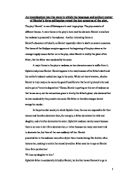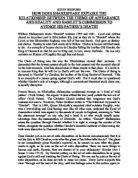Here, the audience learns that Hamlet will be feigning madness at some point in the play, but we do not know yet exactly why he is doing this. Perhaps if only Hamlet had seen the ghost, it could be said that he was truly mad, but the fact that three people saw the ghost even before Hamlet knew about it shows that he is not mad, and that the ghost must truly exist. Shakespeare uses Horatio as an unquestionably sane alibi for Hamlet’s encounter of the ghost, so if he was to reveal what the ghost had told him, Horatio could support him.
Another point to note is that when Hamlet is speaking in private with the ghost, and Horatio and Marcellus come running in, Hamlet tells them that he has good news. This is the first glimpse of Hamlet's ability and inclination to manipulate his behaviour to achieve effect. Clearly, Hamlet is not feeling cheerful at this moment, but if he reveals to the guards the severity of the news, they might suspect its nature and report it to the King.
Hamlet's actions in the play after meeting the ghost lead everyone except Horatio to believe he is crazy, yet that madness is continuously checked by his consciousness of action, which never lets him lose control. For example, Hamlet questions his conduct in his soliloquy at the end of Act 2 scene 2, but after careful consideration decides to go with his instinct and prove to himself the King's guilt before proceeding rashly. Hamlet employs some travelling players to act out a play called ‘The Murder Of Gonzago’, with an extra speech modified by Hamlet inserted into the play. Hamlet later reveals in his soliloquy that he is planning to recreate his father’s murder in a play and watch the reaction of the King. From his reaction, Hamlet will know whether the ghost was telling the truth, or whether Claudius is innocent. This shows the audience that Hamlet is in a very clear state of mind, because to formulate such a cunning and intricate plan, one must be quick-witted and very sharp.
Even after the King's guilt is proven with Horatio as witness, Hamlet again reflects and uses his better judgement in the soliloquy at the end of Act 3 scene 2, before seeing his mother. He recognizes his passionate feelings, but tells himself to "speak daggers to her, but use none," as the ghost instructed. Again, when in the King's chamber, Hamlet could perform the murder, but decides not to in his better judgement to ensure that he does not go to heaven by dying while praying. Even in his clearly poignant situation, Hamlet is cool and calculated, thinking through every step before taking it. As Hamlet tells Guildenstern in Act 2 scene 2 "I am but mad north-north-west: when the wind is southerly I know a hawk from a handsaw." This statement reveals out-right Hamlet's intent to fool people with his odd behaviour. This is after Polonius' comment earlier in the same scene, "though this be madness, yet there is method in't.”
In the final act, Claudius and Laertes plot together to kill Hamlet, but their plan backfires, and Gertrude dies by drinking the poison meant for Hamlet. Laertes wounds Hamlet with the poisoned sword, and Hamlet does the same to Laertes. When they realise that they are dying, Hamlet wounds the King also, so that his purpose was fulfilled, showing that he was still thinking clearly enough to remember that his duty was to avenge his father’s murder.
Compare the copious evidence against Hamlet's madness with the complete lack of evidence for Ophelia's sanity after her father's murder. Her unquestionable insanity puts Hamlet's very questionable madness in a more favourable light. In Act 4 scene 5, she is quite obviously mad, and unlike Hamlet, there seems to be no method to her madness. All Ophelia can do after learning of her father's death is sing. The death of her father combined with Hamlet’s rejection of her is too much for her to bear, and she does not sing a mourning song at the beginning of the scene, but rather a happy love song, indicating that she has slipped into insanity
Later, when she meets with Laertes, she says to him: There's rosemary, that's for remembrance; pray you, love, remember. And there is pansies, that's for thoughts.
Laertes: A document in madness, thoughts and remembrance fitted. Thought and afflictions, passion, hell itself, She turns to favour and to prettiness. (Act 4 scene 5, lines 179-89)
While the Queen tells Laertes that an "envious sliver" broke and flung Ophelia into the river, and that her death was inadvertent, the clowns in Act 5 scene 1 confirm the reader's suspicion that she did not die so accidentally. ‘Is she to be buried in Christian burial when she wilfully seeks her own salvation?’ (Act 5 scene 1)
Ophelia's breakdown into madness and inability to deal with her father's death and Hamlet's rejection is dealt with neatly and punctually. There is little evidence against her madness, compared to Hamlet's intelligent plotting and use of witnesses to his actions. Therefore, by defining true madness in Ophelia, Shakespeare is able to indirectly tell the audience that Hamlet is not truly mad, but mad in craft.
The major difference between Hamlet’s antic disposition and Ophelia’s true madness is that Ophelia ends up committing suicide, whereas Hamlet is actually murdered. Also, hamlets ‘madness’ lasts for a very long time throughout the play, whereas Ophelia's madness lasts for a very short period before it overwhelms her and drives her to death. Another point to take into consideration is that Hamlet was instructed to carry out revenge for his father’s death, which is why he feigned madness, but Ophelia had no reason to act mad, so her insanity was genuine. Throughout the play, the audience are constantly being reminded by Shakespeare that hamlets madness is merely in craft, but there is no indication that Ophelia is not truly mad, so the audience are left to conclude that she has lost her mind, and Hamlet has managed to retain his sanity.
However, there are some similarities in the way both Hamlet and Ophelia are presented by Shakespeare. For example, both of them speak incoherently in the presence of the King and queen, and they both want to die at some point. Hamlet wishes he were dead in his soliloquy in Act 1 Scene 2, and Ophelia fulfils her own wish and commits suicide in Act 4 Scene 7.
Having analysed the way in which Shakespeare presents Hamlets antic disposition and Ophelia’s madness, I have been able to reveal some similarities and differences in the presentation. In my opinion, there is a very clear contrast between Hamlet and Ophelia. I have acquired this judgment due to the fact that Hamlet had a reason to feign madness, whereas Ophelia had no reason to be mad in craft, so her insanity was genuine and born involuntarily, while Hamlet intentionally manifested his false lunacy. This contrast allows the audience to have a better understanding of the fact that Hamlet is not really mad, but Ophelia is.







